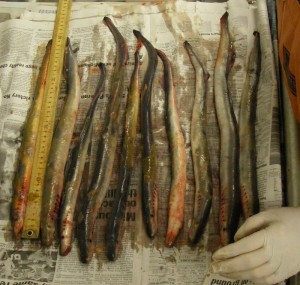I like to think of myself as someone who will try anything once (especially when it comes to food), but there are a few things I have a hard time stomaching, or even imagining to stomach. I recently encountered a photoshopped picture of a lamprey. I was comforted to know that it was ‘shopped, but still decided that there is no way in hell I’d ever eat one:
Then, a friend of mine who studies the subsistence patterns of Yukon River folk sent this picture along, telling me that they’re often eaten smoked and canned here in Alaska:
I thought to myself, “Ok, that’s kind of like sardines. I can handle that. They’re probably good.” Then, sadly, I looked up “lamprey” on Wikipedia and saw this:
And now I’m back to “Um, no.” But when does disgust turn to “Taboo”? To say that a food is “taboo” implies a wider concept that is culture-specific and has larger social implications than mere personal revulsion. I mean, my uncle refuses to eat Mayonnaise… EVER, but that doesn’t mean that mayo is a taboo food. There is a line between disgusting and taboo that extends beyond the personal. Taboo foods are those that a culture deems unacceptable for ethical or religious reasons, not simply things that seem gross.
The etymology of the word “taboo” comes from a Tongan word tapu, which specifically that which is forbidden to eat (see Capt. James Cook’s memoirs for an account). We’ve come to associate the word with other forbidden things such as incest or infanticide, but taboos generally revolve around forbidden acts in the realm of sex, food, and death. Food Taboos have been in the news recently with the Horse Meat Controversy brewing in England, but numerous cultures enjoy horse meat (such as the French and Canadians) and this discrepancy merely highlights the cultural basis of what one considers to be “taboo” when it comes to dinner, and its a basis grounded in the way a culture defines the role of that which is to be eaten.
Animals that a culture deems to be either a companion animal or a deity often obtains the status of taboo but also animals that are associated with evil or the unclean. Dogs and cats in the U.S. (companion animals) are eaten with relish in some Asian countries but were certainly not eaten, but rather worshipped, in ancient Egypt. Cows, which Americans consume in vast quantities, are holy and on the list of taboo foods for Hindu populations in places like India. And pigs, my personal favorite (especially in the form of bacon) are considered unclean and therefore forbidden by Muslims. Food taboos are not universal, obviously.
“Rotten” food, which you would think is a universal taboo, is called a “delicacy” when eaten in traditional settings by adults who have acquired a taste for said delicacy. Where one might experience the feeling of disgust at fermented shark (Icelandic Hakarl) Icelandic people think of it as a traditional food. Rachel Herz wrote an interesting piece on “controlled rot” for the Wall Street Journal entitled “You Eat That?” in which she lists a number of fermented (rotten? taboo?) foods enjoyed around the world. Even bodily fluids, which again I assumed to be a universal taboo, find their way into certain dishes, noting that “you might try to wash down your hákarl with the Ecuadoran aperitif chicha, which combines the alcoholic perks of fermentation with a disgusting bodily fluid. Chicha is made from a masticated blend of boiled maize (or yucca root) and human saliva.” I wonder if, on some level, eating something that smells, tastes, or even appears dangerous or unclean is a kind of catharsis, a way for us to do something we aren’t supposed to do in a sanctioned and ritualized manner, and therefore exorcising the demons that muck about inside our own interiors.
I admire eaters who, in spite of their disgust, take the bull by the horns and try everything, no matter how taboo (though I have yet to meet someone who has tried human flesh for any reason other than starvation (note: I don’t want to actually meet that guy). Andrew Zimmern of Bizarre Foods is first to mind, but even Bourdain manages to sneak in things I find a little squicky: scorpions and crickets to name a few. It’s always fun to see how either of them manage to either reveal or hide their reaction from their foreign hosts. Here is a clip of Andrew Zimmern trying Icelandic Hakarl on his show Bizarre Foods:
If you’re looking for a broader, more comprehensive look into taboos, try watching National Geographics series, Taboo, and specifically this one: “Taboo: Extreme Eats.” YouTube does require viewers to verify they are old enough to watch the videos, which means they’re interesting.
If you’re writing about food, the topic of “Taboo” one that can generate plenty of material. Thinking about what you consider to be “gross” versus “taboo” is a good place to start, then looking into why something is taboo is a pretty rich source of material. You might also mull over the impact that concepts like hygiene, xenophobia, or class have had on what a culture considers to be taboo. Comb through some of the resources below to find out more.
Further Resources:
A previous Tart Little Piggy entry: “Eskimo Ice Cream and the Appeal of the Exotic”
“You Eat That?” by Rachel Hertz for the Wall Street Journal
Ethics from Farm to Table: The Food Ethics Blog by Chris MacDonald
Bizarre Foods with Andrew Zimmern (full episodes on YouTube)
“Delicious Rotten Food” an entry by Geordie Guy on Totally Obsessed with Food
“Food taboos: their origins and purposes” by Victor Benno Meyer-Rochow (PDF)
YouTube episode of National Geographic’s “Taboo: Extreme Eats” (Link to the YouTube channel: http://www.youtube.com/channel/SWKYmdziHW25A)
“Much Depends on Dinner: The Extraordinary History and Mythology, Allure and Obsessions, Perils and Taboos of an Ordinary Meal” by Margaret Visser (Amazon Link)
Three Voyages of Captain James Cook Round the World (free ebook from Google Play)
Stephen Colbert on happily consuming “the rest of Noah’s Ark.”



This is great, Madara. When you mentioned “disgust” early on, I thought I would share this Klaus Pichler link for you to ponder since you are an artist. I give it to my Art/Music/Thr 200x students to review so they can decide for themselves if this is art or just simply disgusting. My vote is both. http://www.kpic.at/index.php?option=com_content&view=category&layout=blog&id=45&Itemid=88&limitstart=6
Is that mold? If so, the colors are beautiful. I don’t find this gross at all but I think it’s a context thing. It’s presented as art (as in: you should look at this) rather than food, so it never really crosses my mind that I would eat it. But if I were to smell it…
A few notes:
a. your phrasing is interesting when you talk about eating human flesh. It implies you’ve met someone who has eaten human flesh who *was* faced with starvation. Have you?
b. The Japanese eat a lot of horse meat. When served sashimi style it’s called sakura-niki, or cherry blossom meat. They also have a horse meat ice cream.
c. You know what else Tapu means? The band that had that awesome song in the 80s. Don’t remember them? Try: http://youtu.be/PSh6SQd8UrI — you won’t be sorry. That they don’t even get a Wikipedia entry breaks my china heart.
a. Unfortunately, this is the song I remember best by them: Heart and Soul
b. comparing horse meat to a cherry blossom is disturbing for some reason
c. I can’t divulge my source for your (a.).
d. Are we doing a geometry proof right now? Cause I feel a Q.E.D. coming on.
a1. I forgot about that one…my girlfriend at the time that song was big, who I had to take a plane and a ferry to see, loved that song. I kind of wanted to forget the song and the girl. So…thanks.
c1. I honestly have no issue with any kind of meat, human or not. Though I have no reason to think I’ll ever try the former. I’d rather eat human than monkey.
d1. I’ve taken to writing everything in the form of lists. Even personal letters.
d1a. Why not?
ergo: Q.E.D.
I wish I could footnote a WordPress comment. I accidentally spelled it “foodnote” at first. Which gives me an idea…
Foodnote? OMG. I love you both for your complete nerdiness. Chris, if a student in my 213 used your format for an outline, I’d object on the grounds that you cannot have a 1 without 2.
Maureen: I don’t believe in your prescriptivist list composition 🙂
I learned my writing from the nuns. We diagrammed day in and day out. I blame my descriptivism on my Catholic upbringing. I’m just not like those descriptivist protestants. I have a Pope! Well, I did til he quit.
Maureen: there’s a reason _Sister Bernadette’s Barking Dog_ is one of my favorite books. I loved diagramming sentences. I’ll stick with my Alexander Pope…